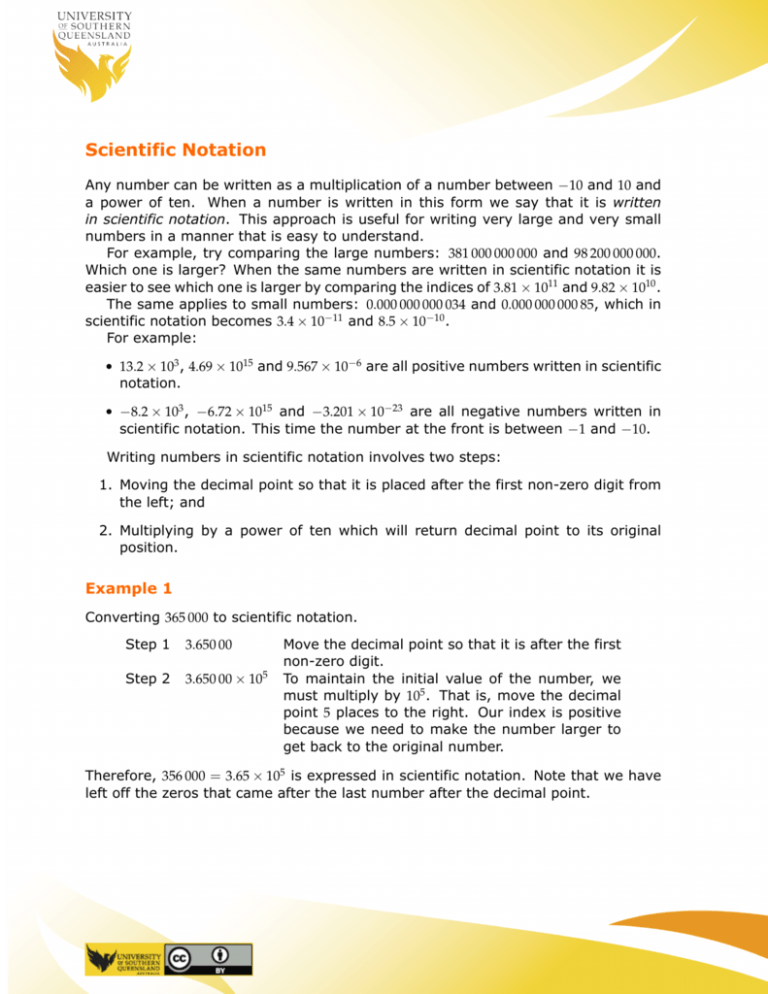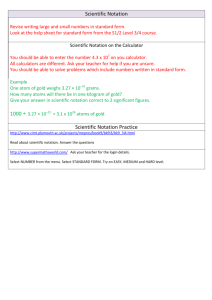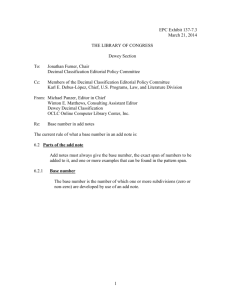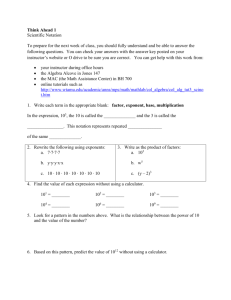Scientific Notation
advertisement

Scientific Notation Any number can be written as a multiplication of a number between −10 and 10 and a power of ten. When a number is written in this form we say that it is written in scientific notation. This approach is useful for writing very large and very small numbers in a manner that is easy to understand. For example, try comparing the large numbers: 381 000 000 000 and 98 200 000 000. Which one is larger? When the same numbers are written in scientific notation it is easier to see which one is larger by comparing the indices of 3.81 × 1011 and 9.82 × 1010 . The same applies to small numbers: 0.000 000 000 034 and 0.000 000 000 85, which in scientific notation becomes 3.4 × 10−11 and 8.5 × 10−10 . For example: • 13.2 × 103 , 4.69 × 1015 and 9.567 × 10−6 are all positive numbers written in scientific notation. • −8.2 × 103 , −6.72 × 1015 and −3.201 × 10−23 are all negative numbers written in scientific notation. This time the number at the front is between −1 and −10. Writing numbers in scientific notation involves two steps: 1. Moving the decimal point so that it is placed after the first non-zero digit from the left; and 2. Multiplying by a power of ten which will return decimal point to its original position. Example 1 Converting 365 000 to scientific notation. Step 1 3.650 00 Step 2 3.650 00 × 105 Move the decimal point so that it is after the first non-zero digit. To maintain the initial value of the number, we must multiply by 105 . That is, move the decimal point 5 places to the right. Our index is positive because we need to make the number larger to get back to the original number. Therefore, 356 000 = 3.65 × 105 is expressed in scientific notation. Note that we have left off the zeros that came after the last number after the decimal point. Example 2 Express 0.003 05 in scientific notation. Step 1 3.05 Step 2 3.05 × 10−3 Place the decimal point after the first non-zero number (in this case after the 3). To maintain the initial value of the number, we must multiply by 10−3 (which is the same as dividing by 103 ). That is, move the decimal point 3 places to the left. Our index is negative because we need to make the number smaller to get back to the original number. Therefore, expressing this in scientific notation form gives: 0.003 05 = 3.05 × 10−3 . Example 3 Convert 3.65 × 105 to ordinary form. Move the decimal point five places to the left (since the 5 is a positive number) to give 365 000. Now try some yourself: 1. Convert the following numbers to scientific notation: (a) 0.01; (b) −0.01; (c) −912; (d) 2 450 113; (e) 0.000 051 263. 2. Convert the following numbers to ordinary form: (a) 2.5312 × 10−2 ; (b) −1.91 × 1012 ; (c) −3.762 531 × 103 ; (d) 7.015 × 10−6 ; (Answers at the bottom of the page) Scientific notation and the calculator Most scientific calculators have the ability to display and calculate with numbers in scientific notation. Unfortunately, they don’t all do it the same way. Some (usually older) calculators will use the EXP key to enter numbers, while others (newer) will use the ×10x key to do this. Also the way that scientific numbers are displayed will vary from calculator to calculator. Please consult your calculator manual for more details. Try entering some of the above scientific numbers into your calculator. Once the numbers have been entered into the calculator they can be used in calculations the same as any other number. Example: To calculate 6.3 × 103 ÷ 1.23 × 10−1 , use the following keystrokes: 6 · ×10x 3 ÷ 1 · 2 3 ×10x (−) 1 = (Remember to use the EXP key if you do not have the ×10x key.) The answer is 51 219.5122. Resources • Other Quicktips flyers; • Online resources at The Learning Centre; • Talk with a learning advisor at The Learning Centre. Answers 1. (a) 1 × 10−2 ; (b) −1 × 10−2 ; 2. (a) 0.025 312; (b) −1 910 000 000 000; (c) −9.12 × 102 ; (d) 2.450 113 × 106 ; (e) 5.1263 × 10−5 . (c) −3762.531; (d) 0.000 007 015;








